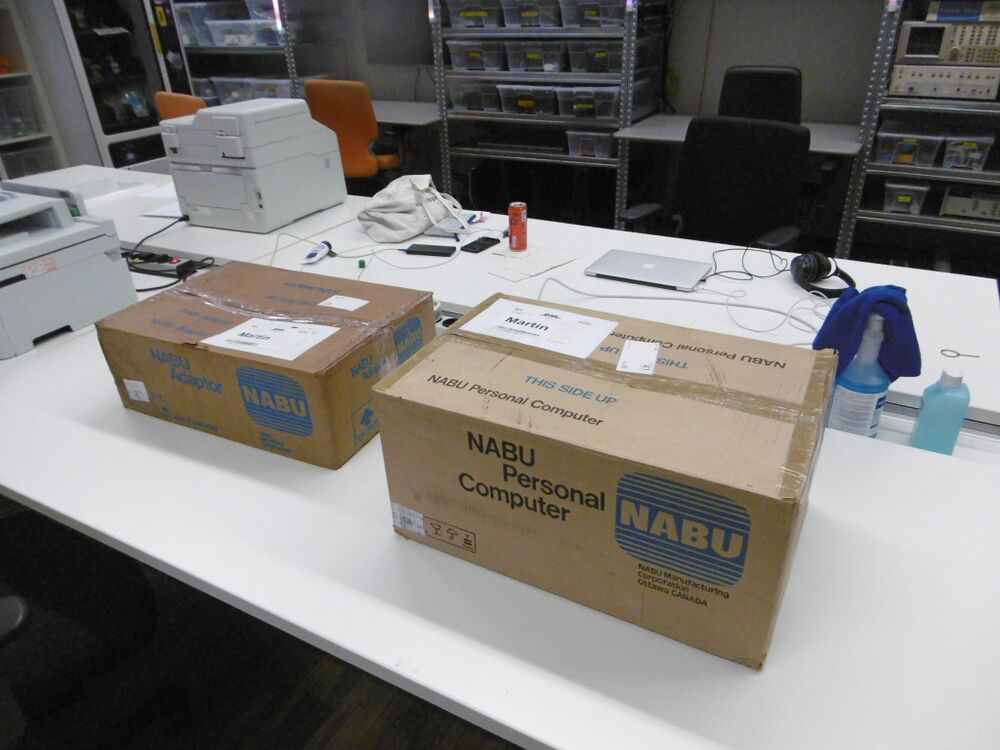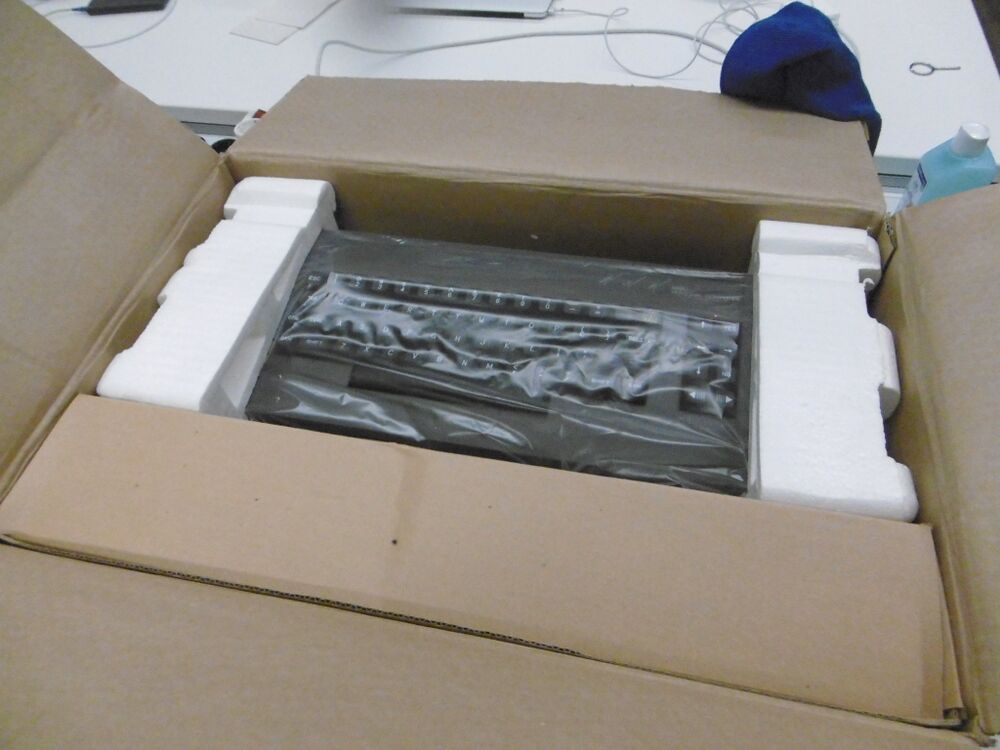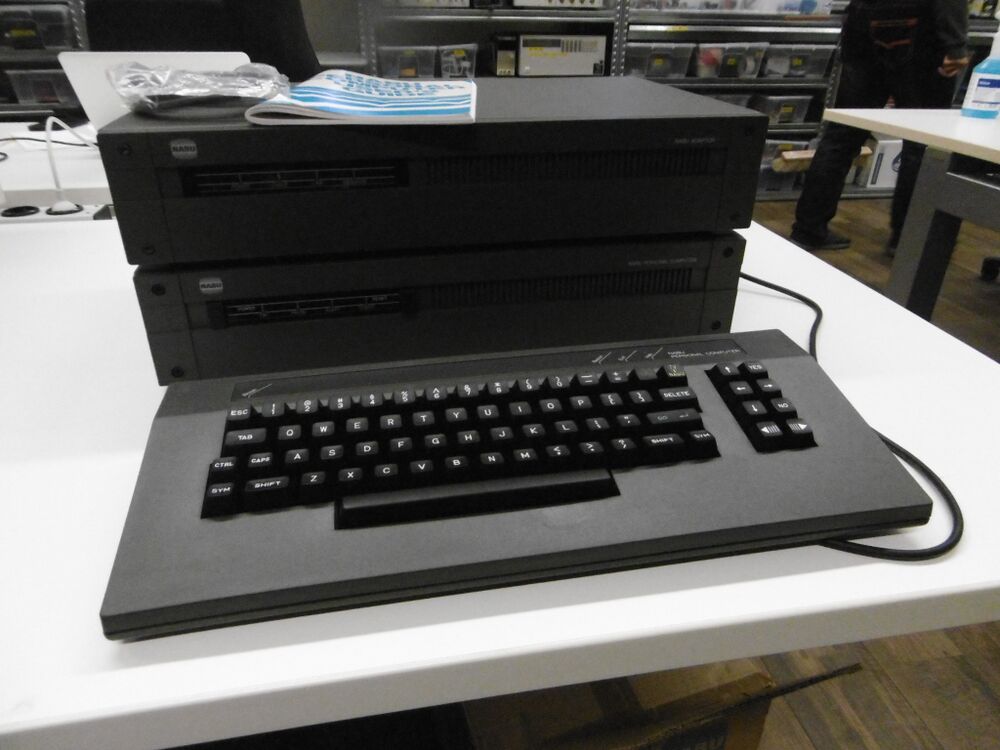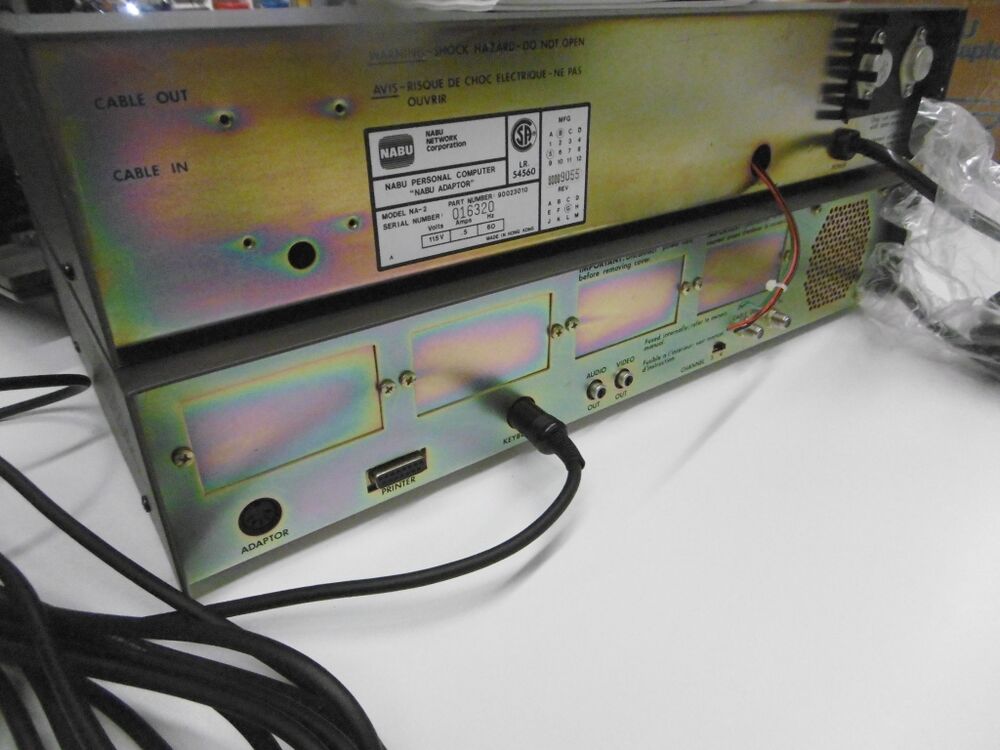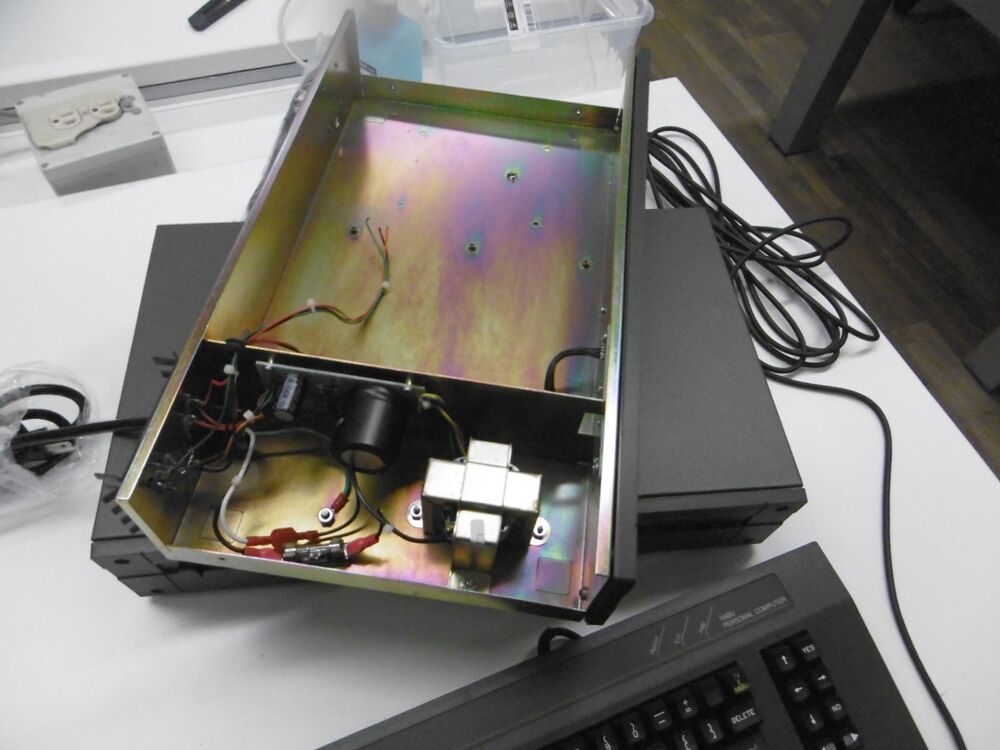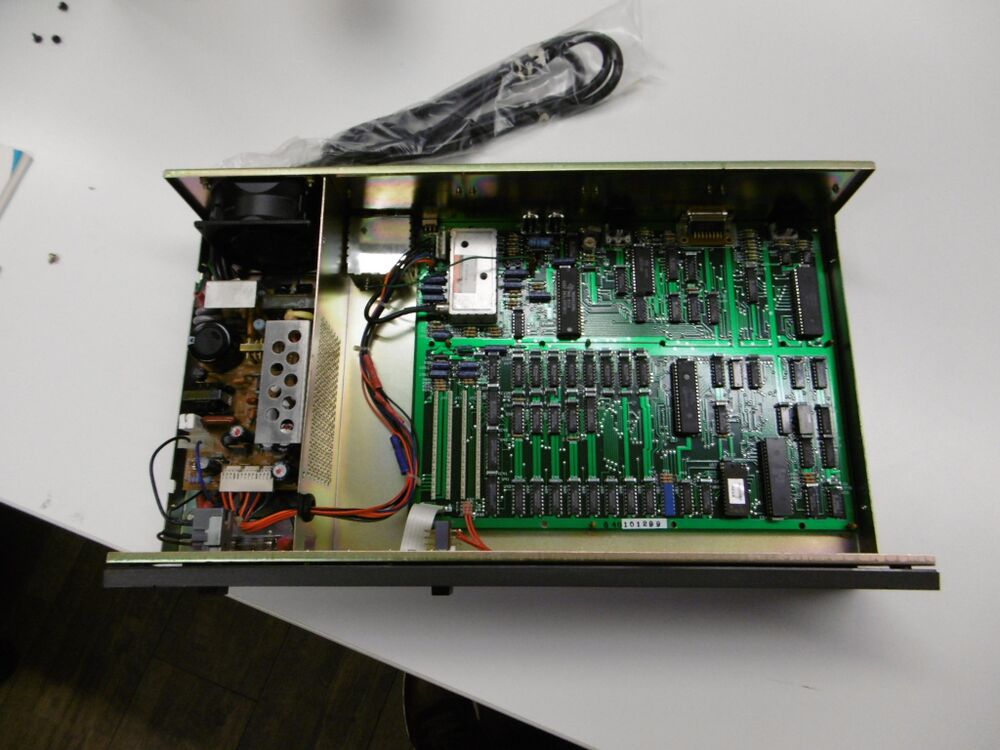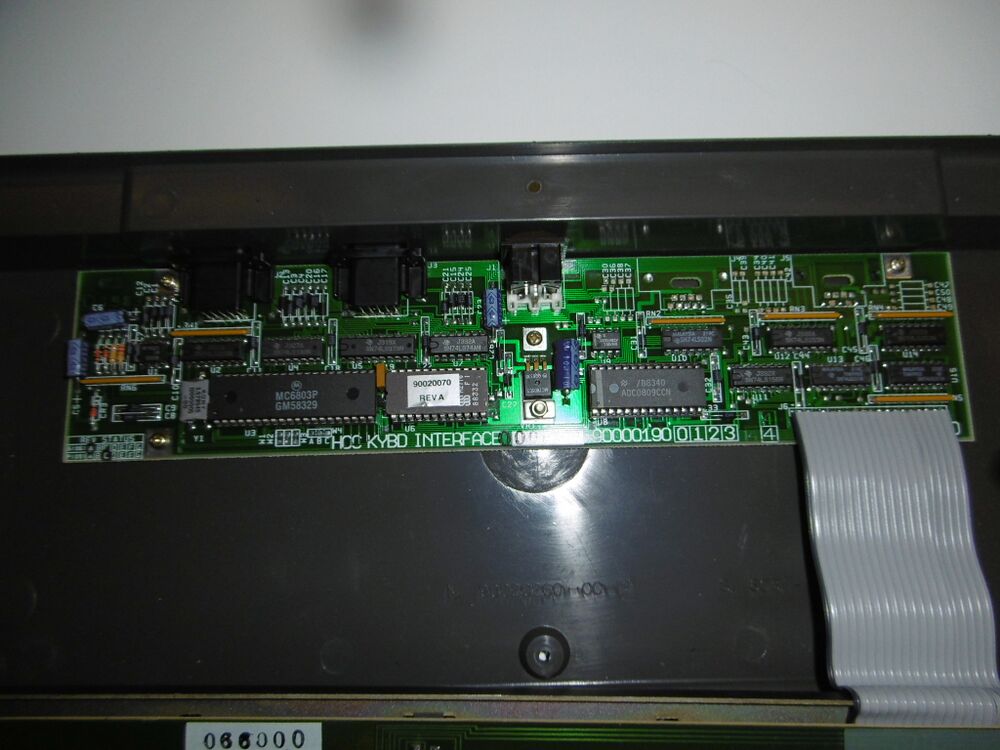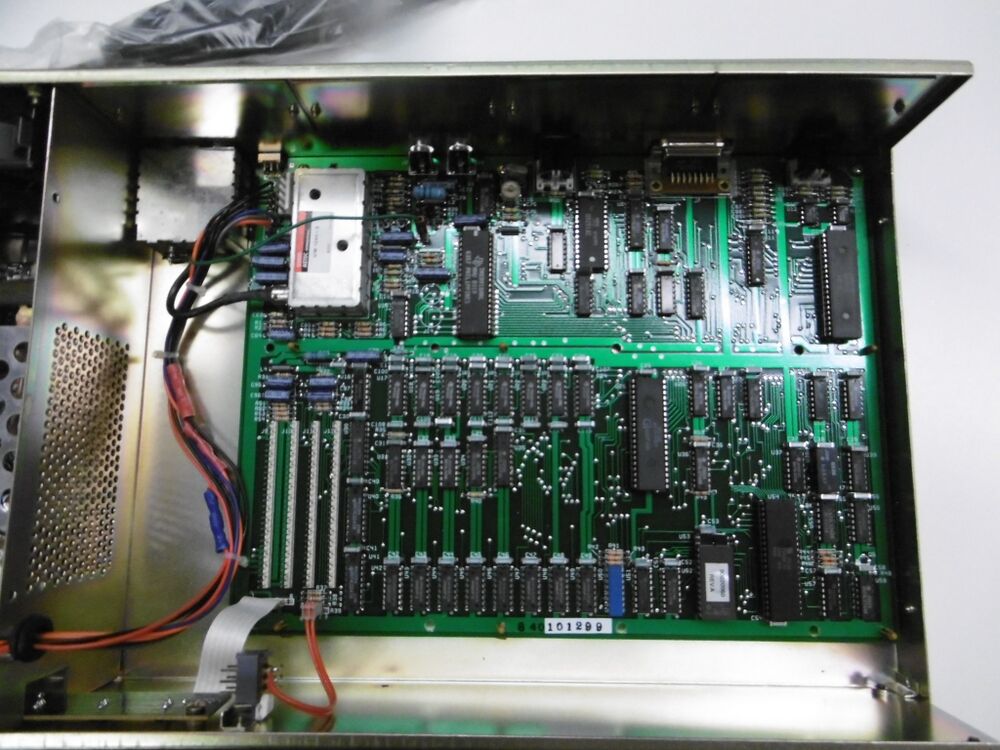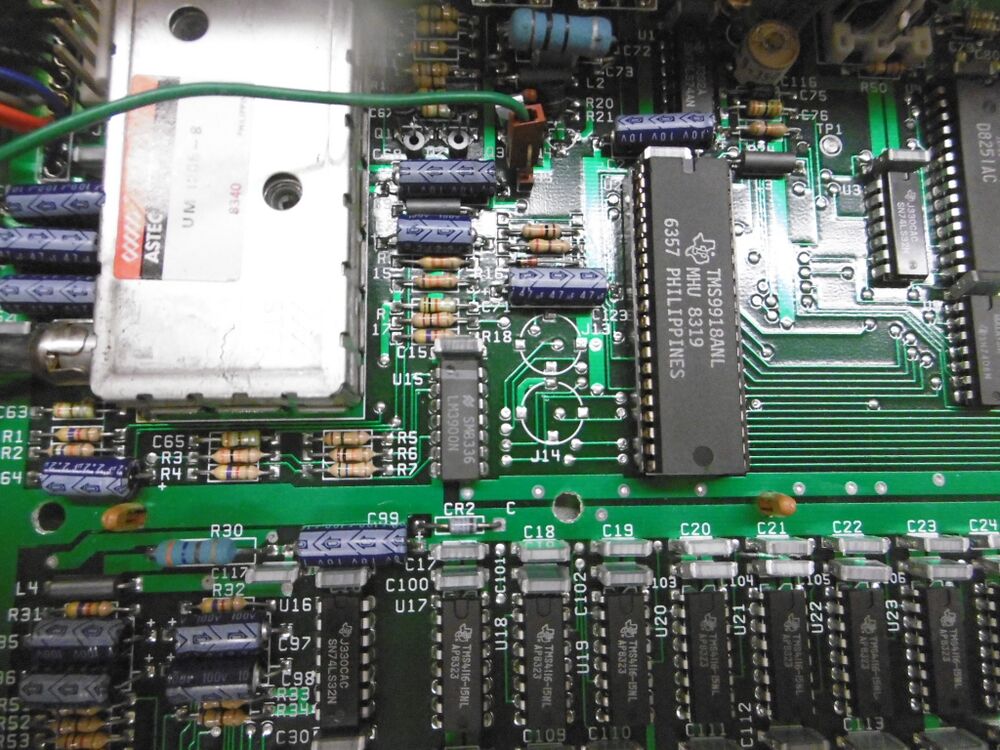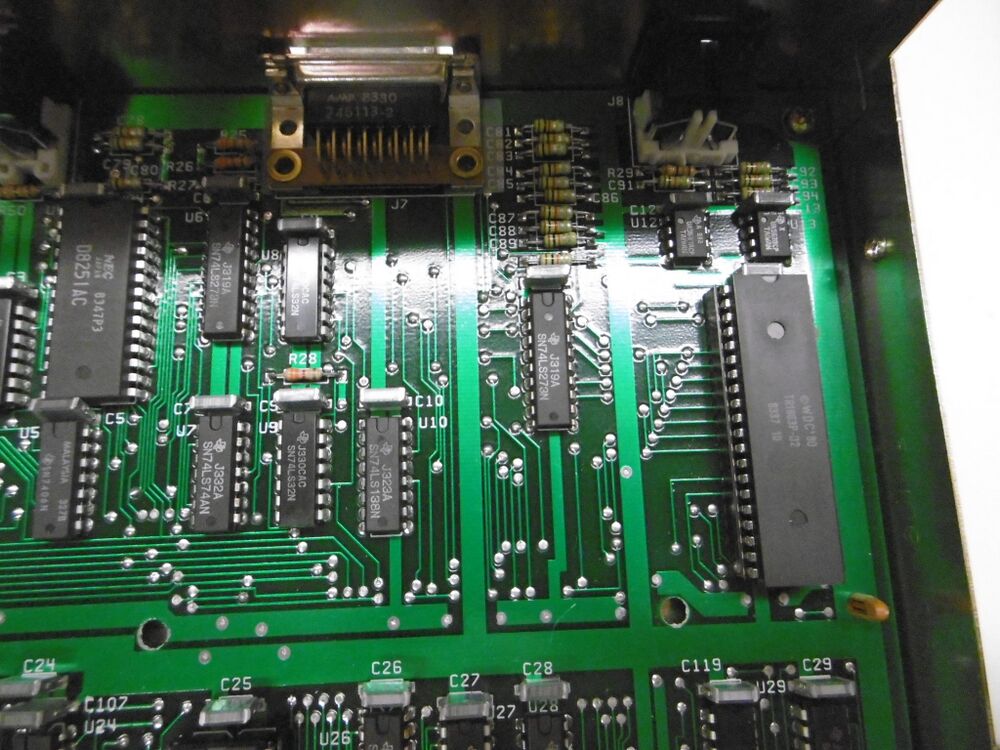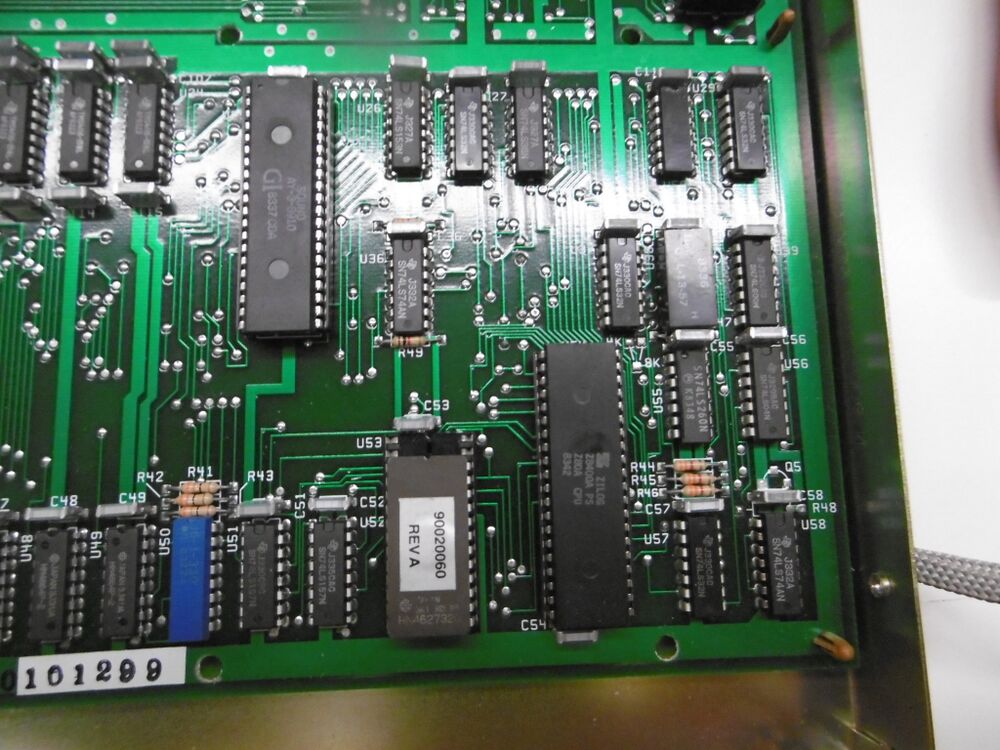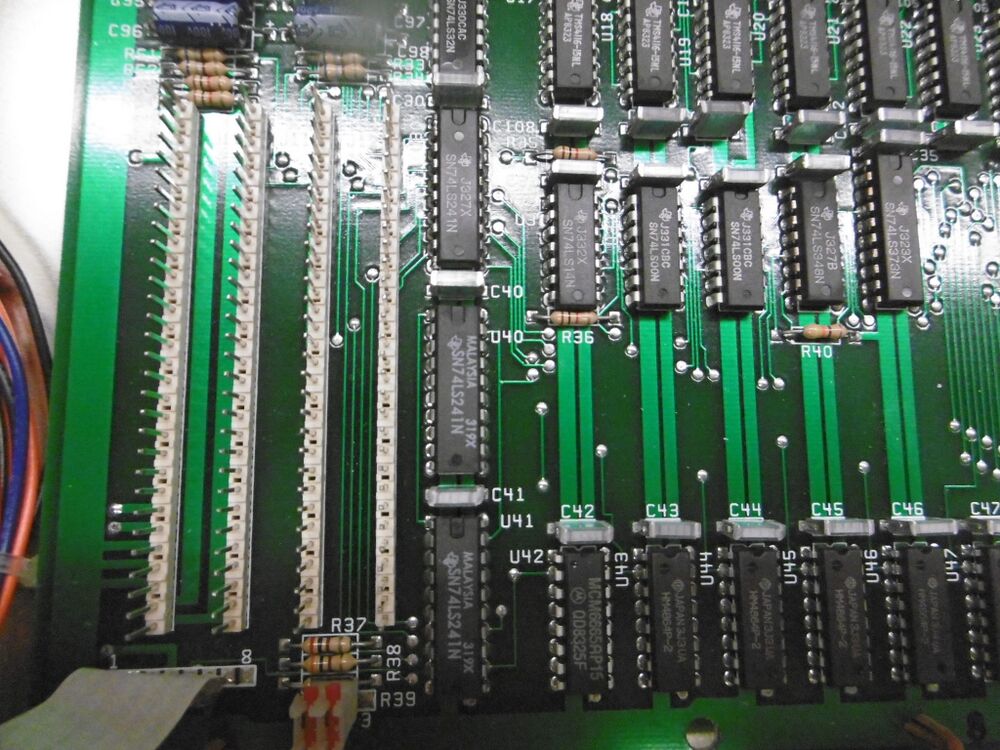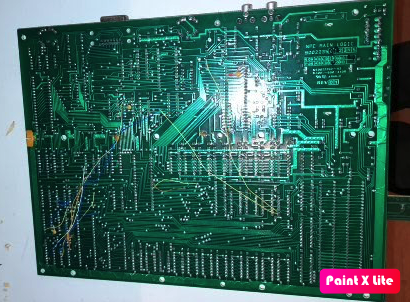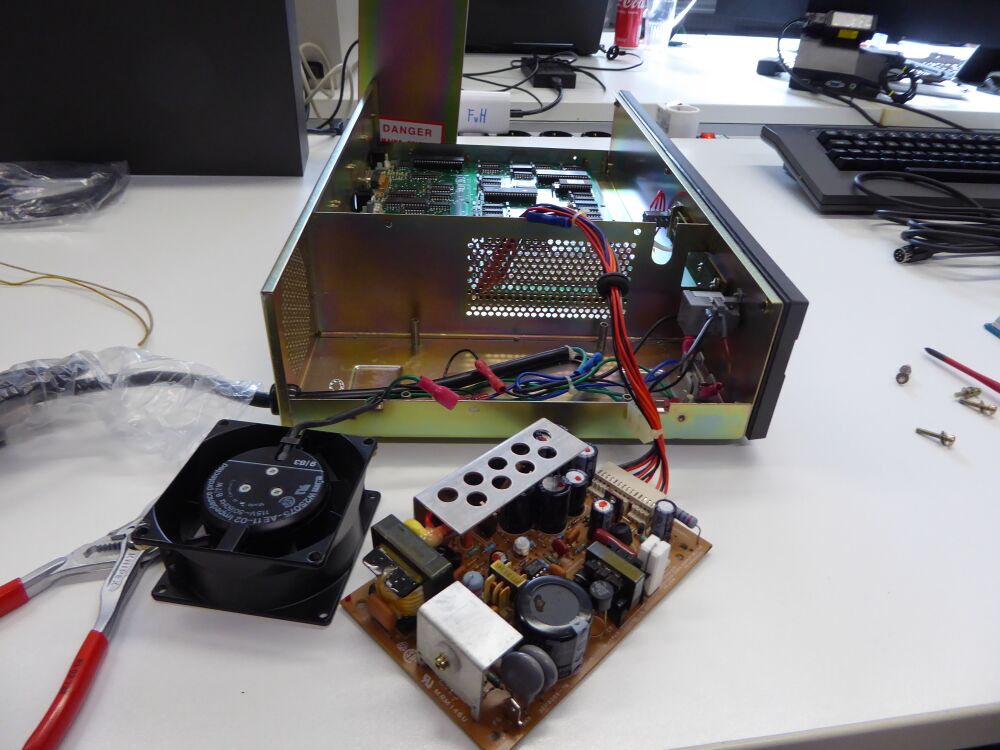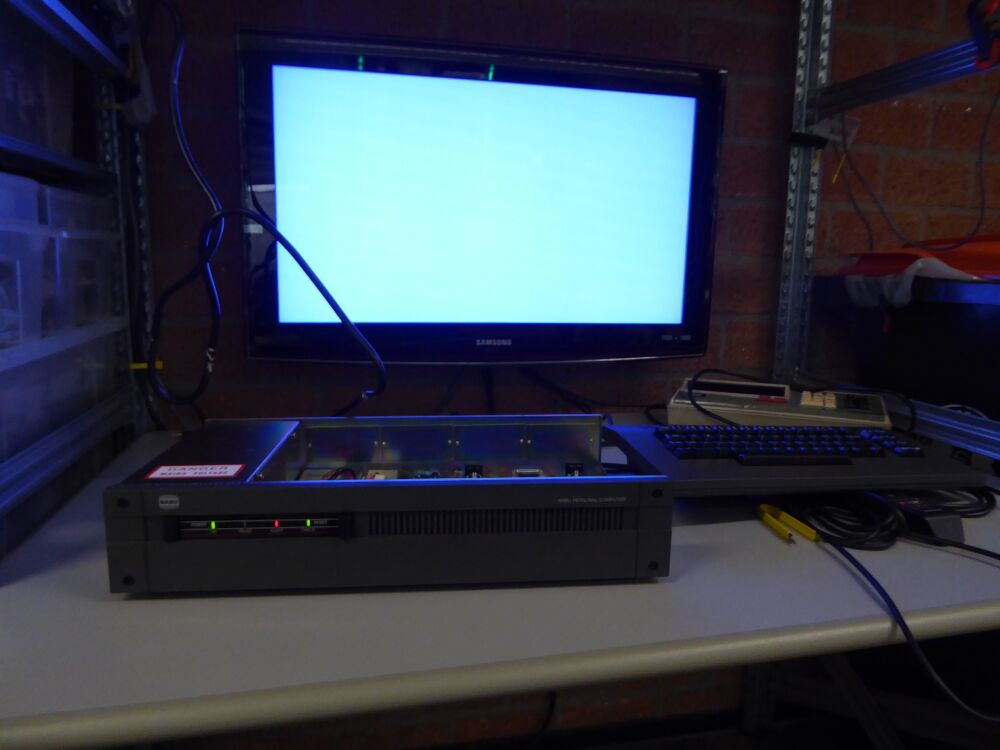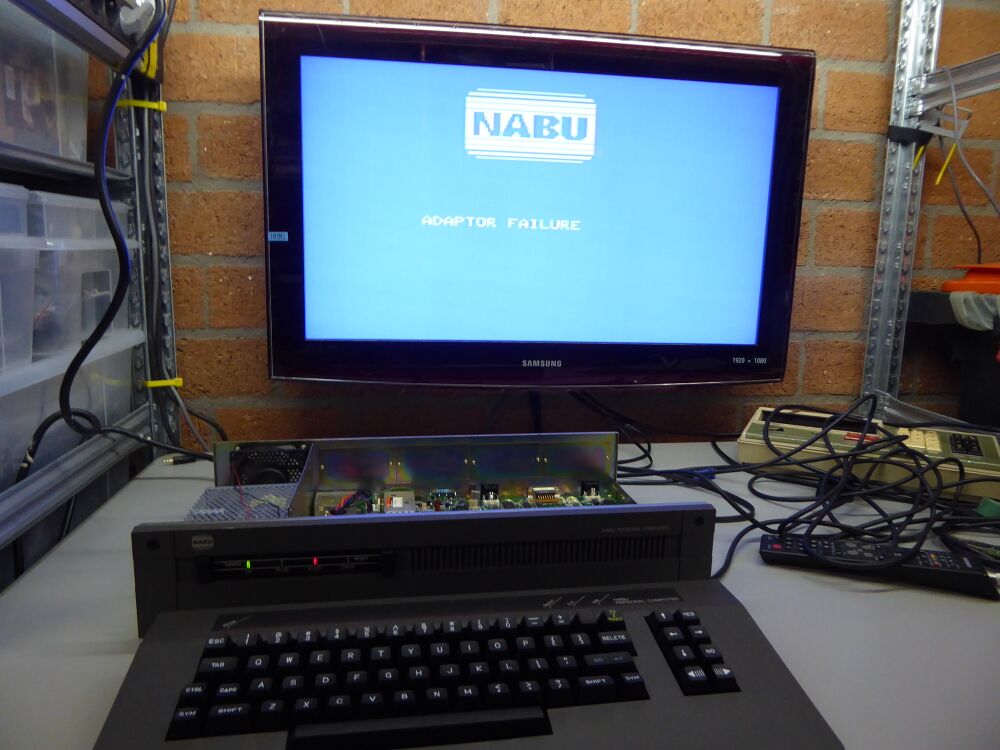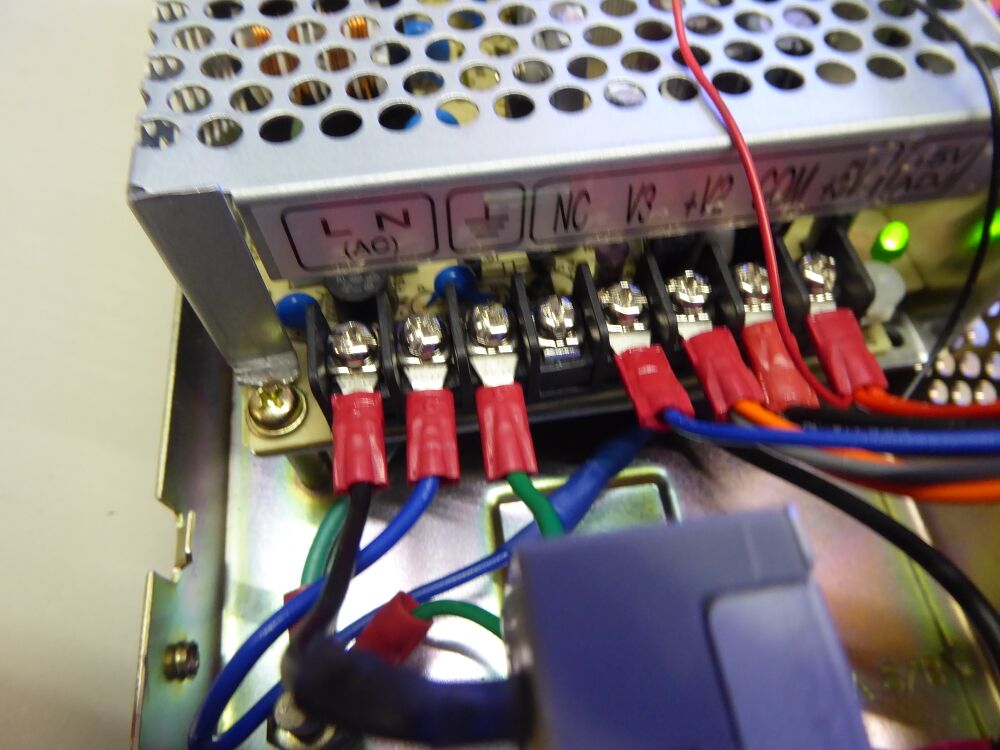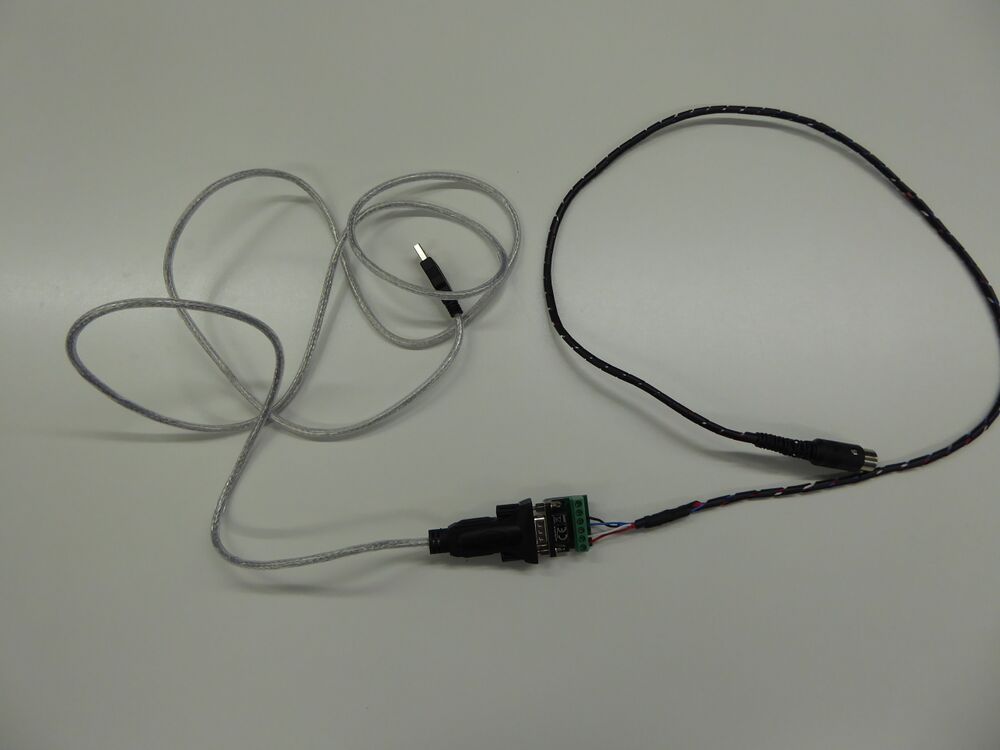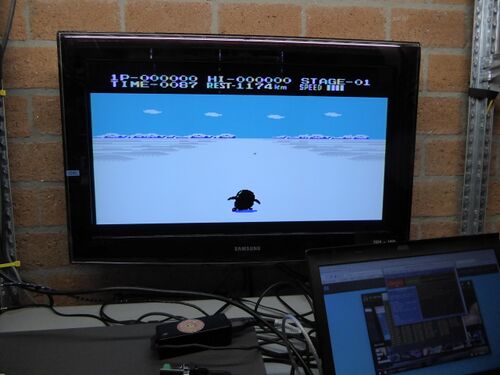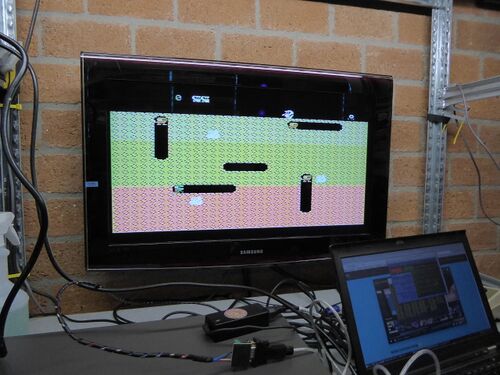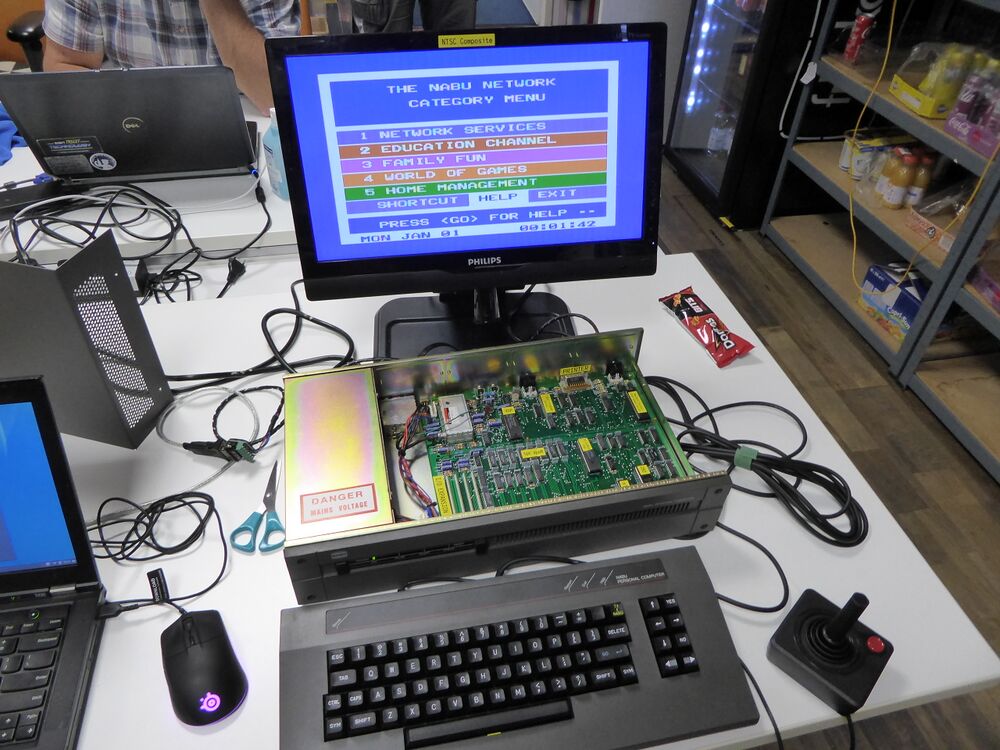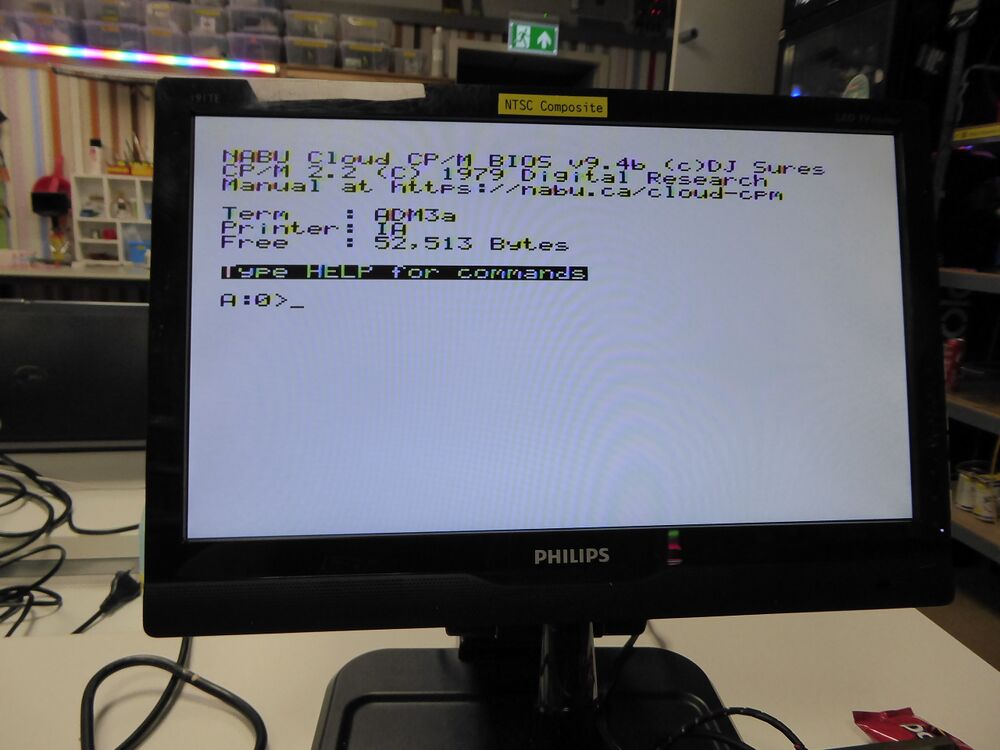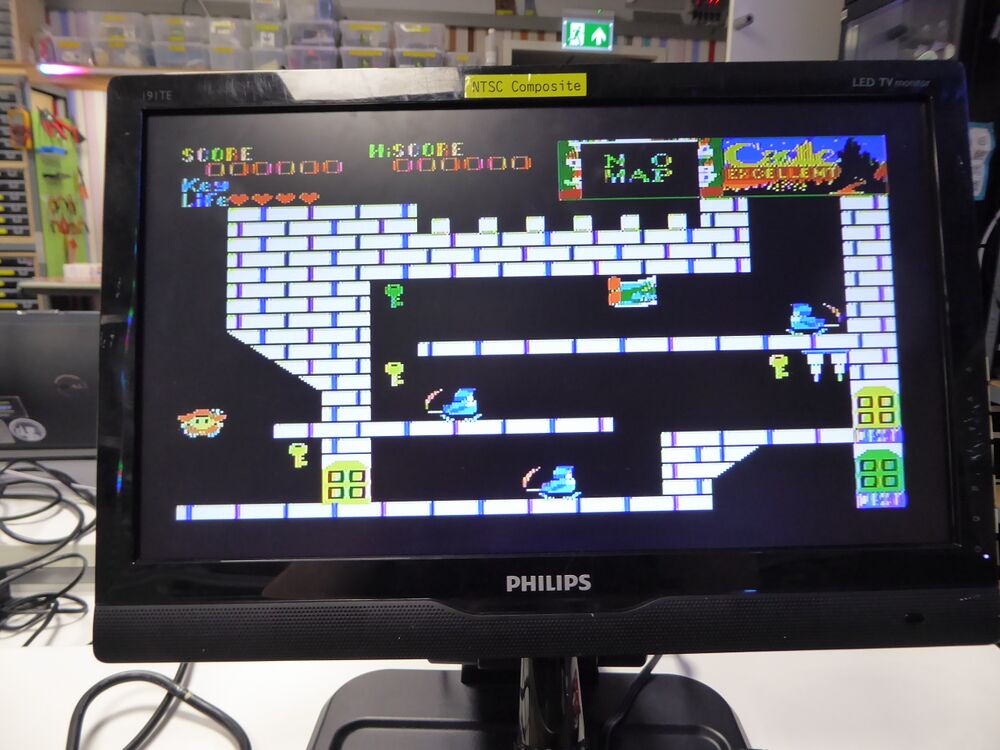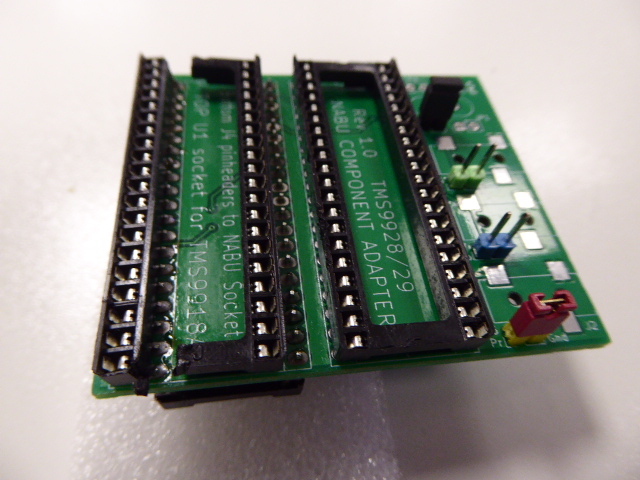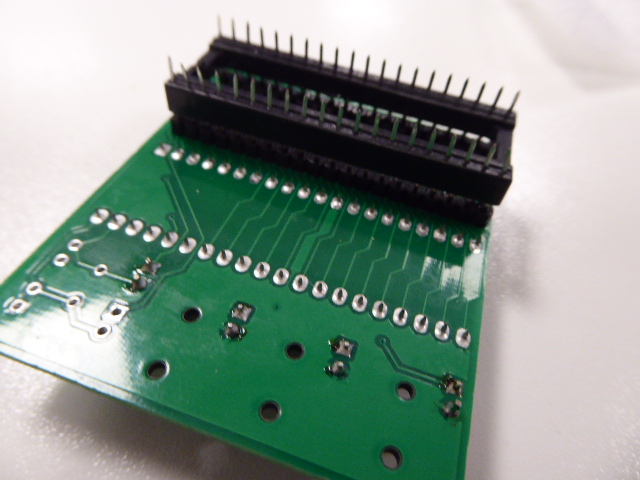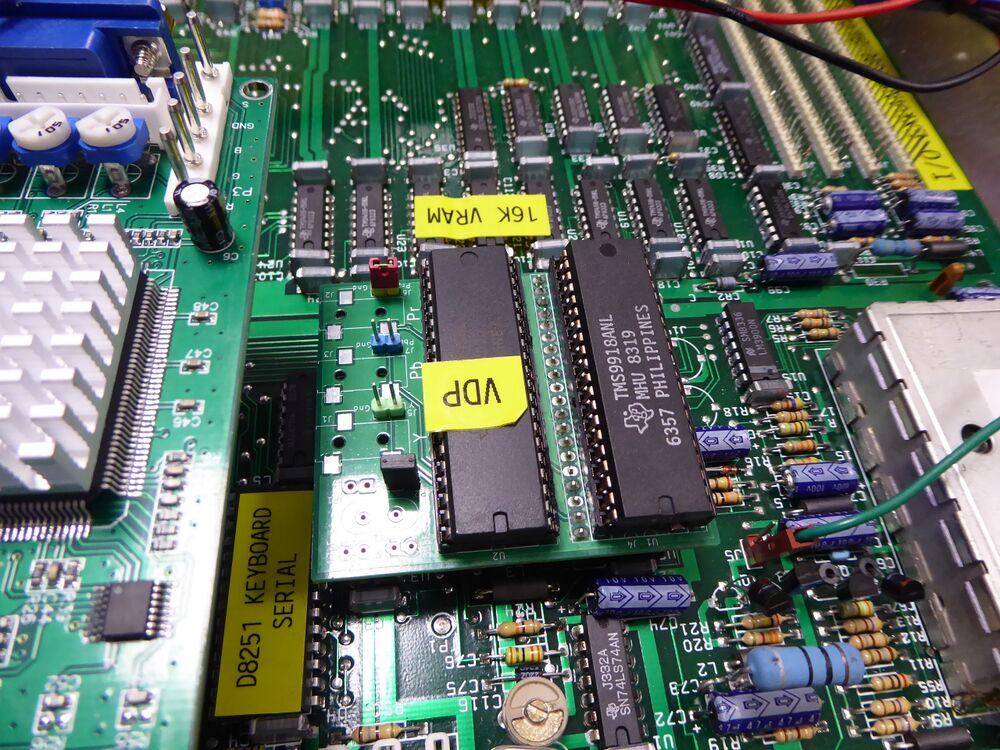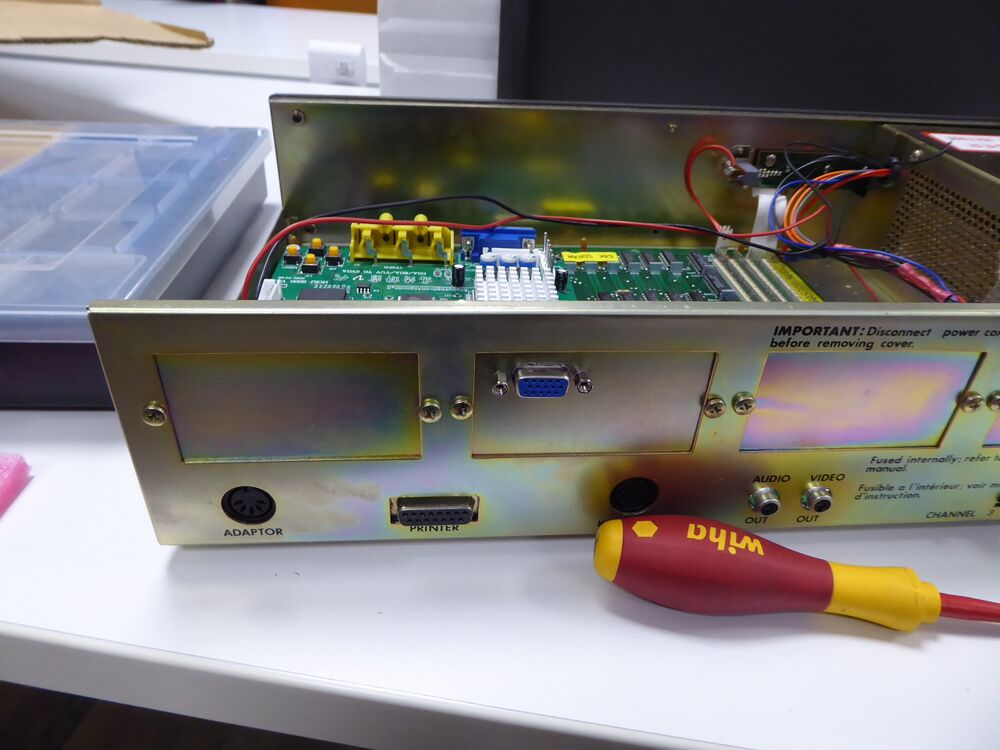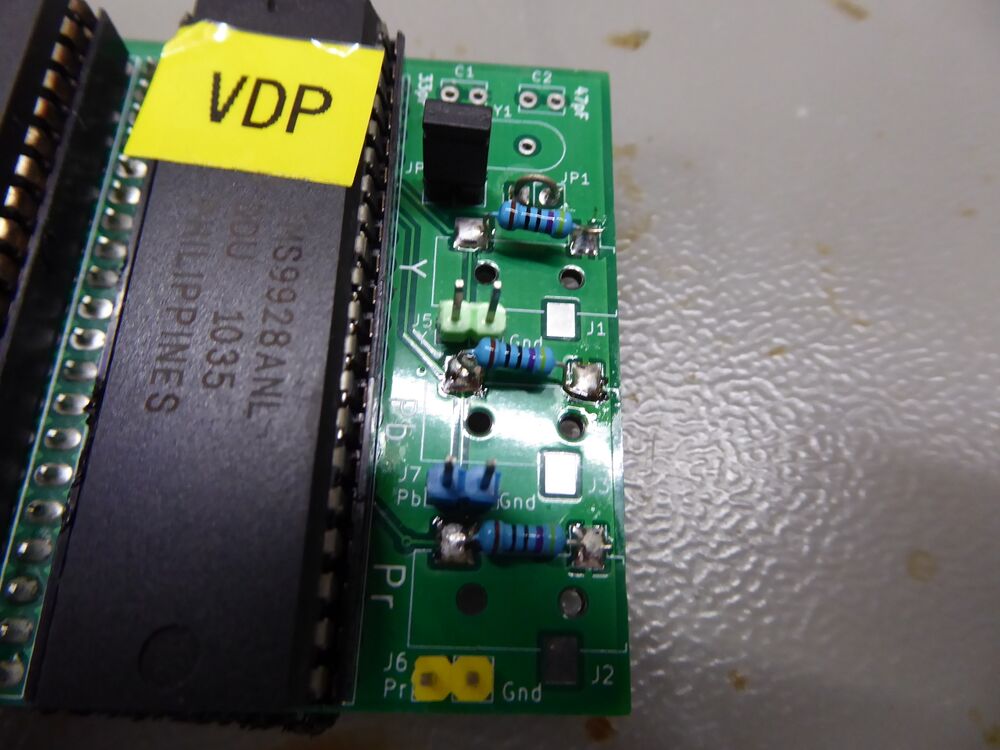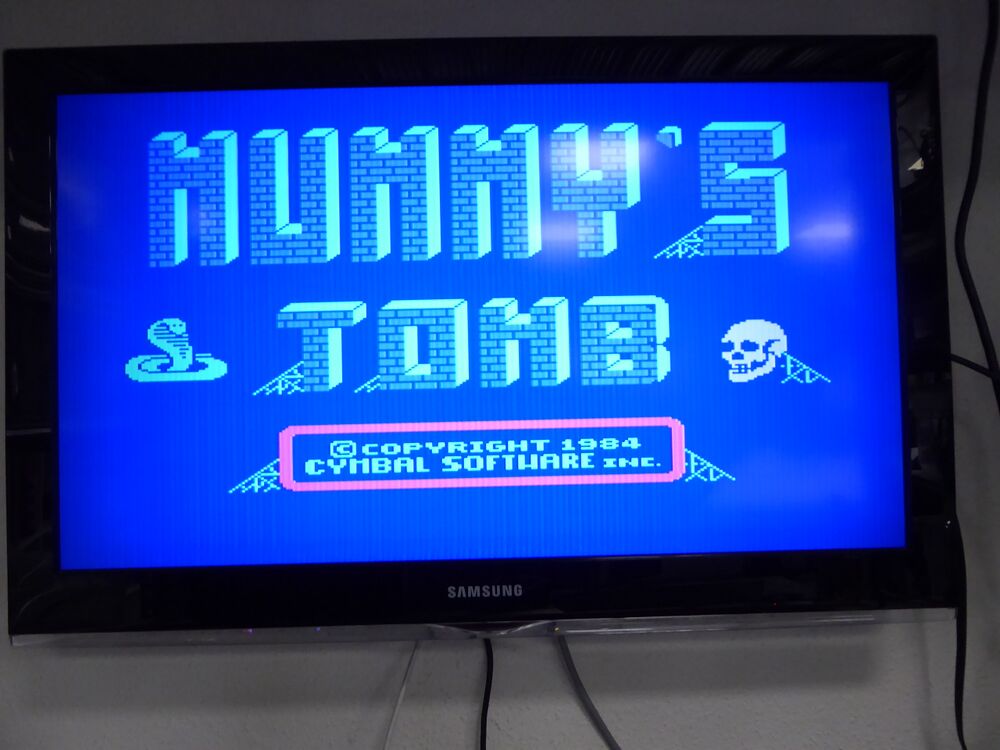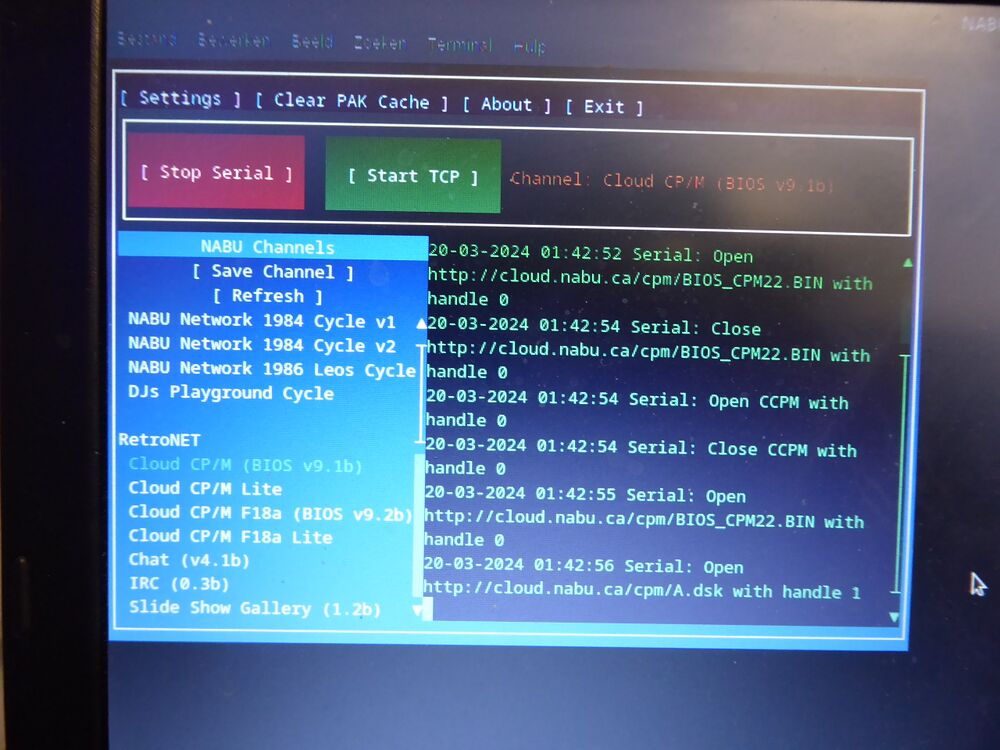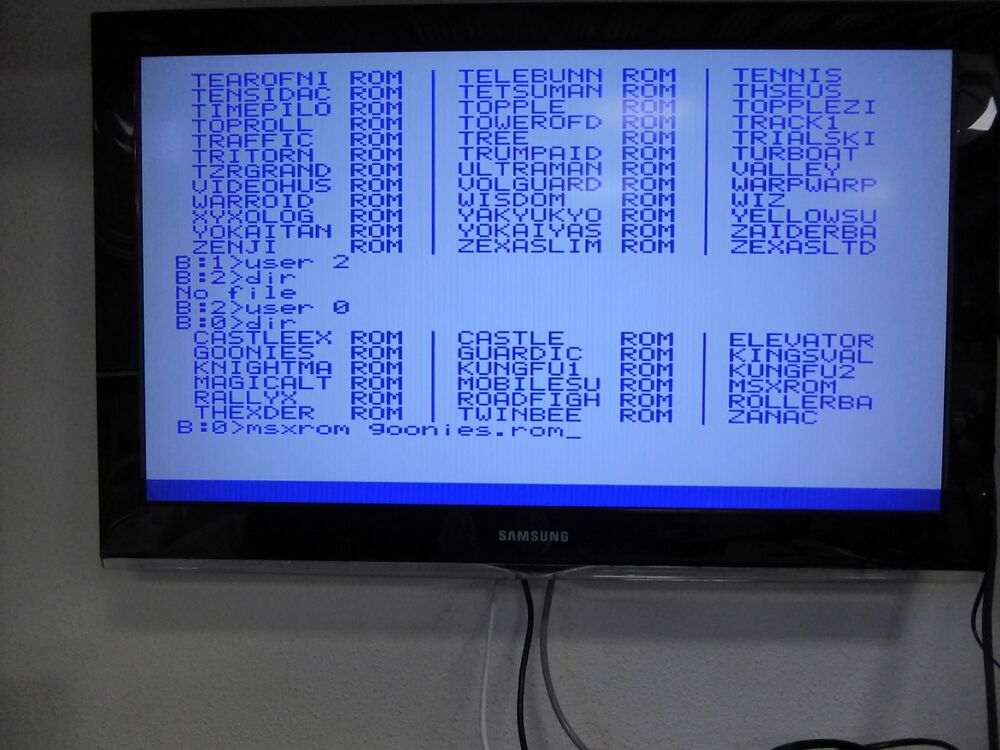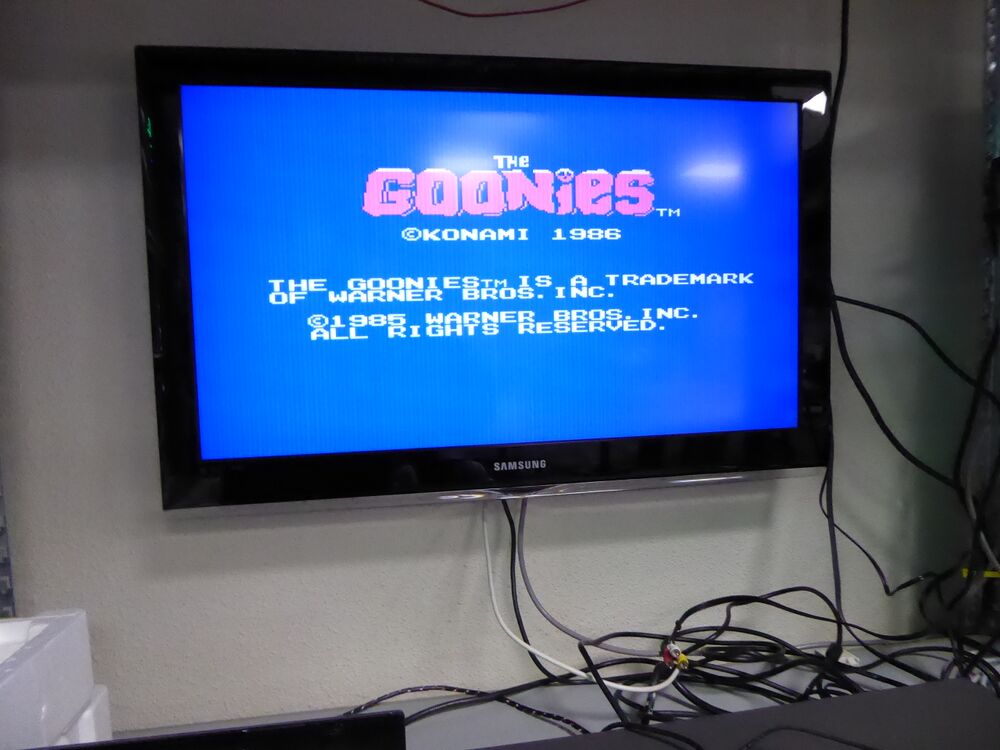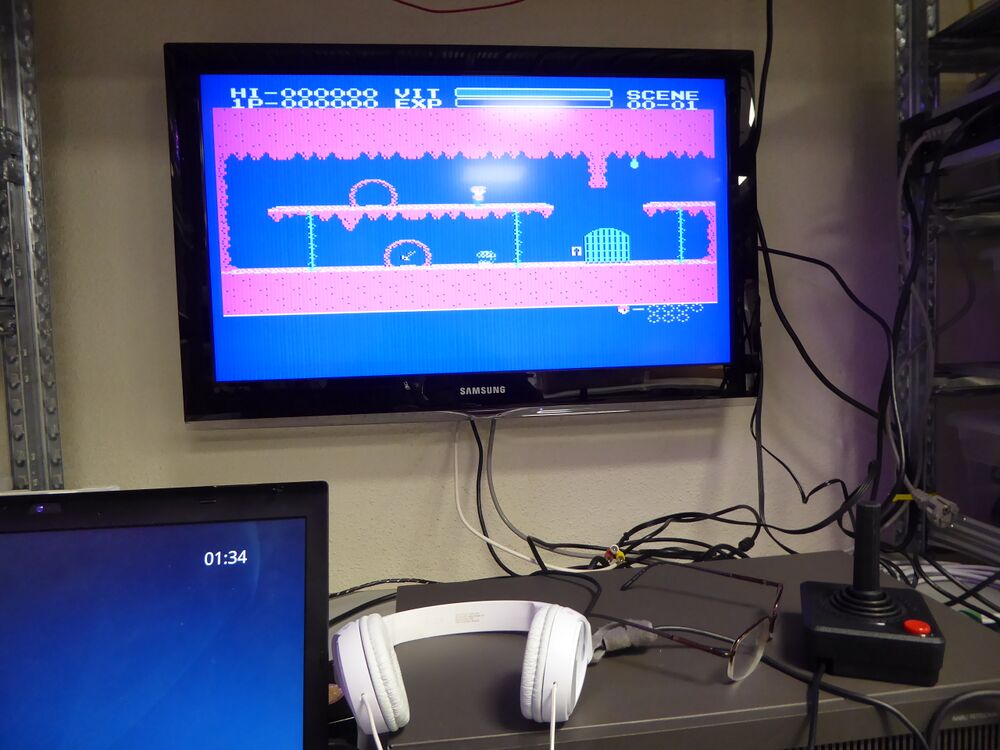Canadian NABU retro computer conversion to VGA out and 220V 50Hz
| Project NABU conversion | |
|---|---|
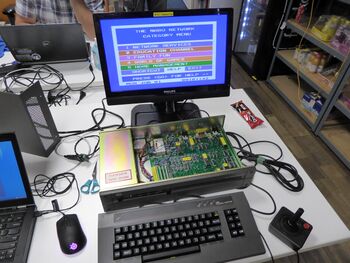
| |
| conversion to Euro version of the NABU PC | |
| Status | Initializing |
| Contact | Mahjongg |
| Last Update | 2024-03-26 |
The NABU Network (Natural Access to Bi-directional Utilities) was an early (1983) home computer system which was linked to a precursor of the World Wide Web, operating over cable TV. It operated from 1982 to 1985, primarily in Ottawa, Canada. Its functionality was then revolutionary, though it was not a commercial success. It has been called "The Internet — 10 years ahead of its time" (even though elements of the history of the internet predate it).
early 2023 an entrepreneur which had bought a stock of one thousand NABU systems after the company had gone bankrupt decided to try to sell this stock, which he had kept for 38 years. And as RETRO collectors discovered this fact, in the US a community quickly establishes itself after a well known retro computer fan and YouTuber Adrian's Digital Basement reported about it https://www.youtube.com/watch?v=HLYjZoShjy0 . another YouTube DJ Sures quickly decided to help to get the NABU functioning again without the Canadian Cable system, his YouTube channel can be found here: https://www.youtube.com/playlist?list=PLNT_tjSHIQ3lGJR_zOqh9gGeHzykR0spq but there are now many people helping out, and re-building their own NABU systems.
This development peaked my interest, and I decided to buy a NABU and accompanying cable set before they were all gone. As I don't have a credit card, or any other means to pay for one, I decided to ask my friends of the national computer games museum in Zoetermeer for help. And immediately one of the technical people (Frans Egmond) reacted to offer his help, and when he discovered what I tried to buy he was hooked too, and wanted one as well. he also told the owner of the museum (Hassan Tasdemir) about the NABU, and he wanted one for the museum. So now there are three NABU owners in the Netherlands, (all NABU buyers are registered in a database) and all of them are from this computer games museum.
The problem in getting a NABU to work in the Netherlands
The NABU is a Canadian system, and that means it is powered with 110 Volt 60 Hz, and has an NTSC composite video output, and neither of these two facts is ideal in the Europe of 2023. So Frans and me decided we would need to adapt the NABU for it to work, firstly we wanted to replace the NABU's power supply and FAN with a 220V 50Hz compatible equivalent.
The NUBU is a Z80 based system that uses a TMS9918A for video, and a AY-3-8910 PSG for sound, and so it has lots of similarities with the MSX computer standard, and several other early home computers and consoles.
The fact the it uses a TMS9918A for the VDP means that just as MSX it can be converted to PAL (and RGB output) by replacing the TMS9918A with a TMS9929A that generated PAL and could also support RGB by using its Y, R-Y and B-Y luminance and colour difference signals to convert to RGB signals.
The NABU is in!
Left the network adapter (project box) right the NABU PC
when you open the box at first you see the keyboard.
So this is how the complete system looks, with the PC below with the network adapter on top, and the keyboard in front. The keyboard has a VERY long cable, multiple meters long.
This is the backside, network adapter on top, PC below.
The network adapter is called a project box by the reseller, and the reason is the the box is completely empty, except for a simple linear regulator, and a few LED's.
Instead the NABU PC is hardly empty! Left the switching power Supply and FAN, and right the mother board. The power supply is of the switching type, and measures 10cm wide, and 15cm deep. the FAN has screw-holes 72mm apart, and is 4cm thick there is 8,8cm height inside.
The keyboard contains an MC6803 CPU which has built in RAM and a small EPROM, but there is also an ADC0809CCN 8-bit A/D converter, probably to support paddles (analog joysticks).
Overview of NABU motherboard
This is a flyover picture of the NABU's main PCB.
top left, the square metal box is the RF switch box, we won't be using anymore, and to the right of it is the RF modulator, we will not need as the NABU also has a composite video output.
Currently it outputs NTSC, (from a RCA connector, the other RCA plus outputs mono audio) but we will change that to PAL, and later also to component video (with a converter box we can convert this to RGB and to VGA.
Details
The top left quart of the PCB is dedicated to the video chip, the TMS9918A NL. The green wire running horizontal over the top controls the RF switch.
Below it is 16K, made from 16K x 1 DRAM chips type TMS4116. This is the video RAM that the TMS9918A NL uses, it is not part of the Z80 memory map but a dedicated 16K only for the video generation. It was first used in the Texas Instruments TI99/4 home computer, but there this ram was used as a complement for the very tiny 16-bit main RAM, on the NABU the Z80 has its own 64K byte of RAM.
To the right (the top right quart) are chips dedicated to various serial interfaces, and a parallel printer interface (DB-15).
The D8251 is a Programmable Communications Interface made by iNTEL (and AMD) it is a somewhat simpler UART than the more commonly used 16550 UART found in PC's, that had build in cache. The 8251 is commonly used for modems, but in this case it communicates with the keyboard using the 6-pin DIN connector to the top left of it, it doesn't use RS232 levels but just 5V TTL levels. Not a serial interface but the Centronics connector top middle is used for a printer interface, and is a parallel port.
The large chip to the right is the Western Digital WDC TR1863 Universal Asynchronous Receiver/Transmitter, a high speed serial interface capable of very high speeds over a RS422 connection, used to the communication with the cable modem. It uses a 5-pin DIN connector, two balanced pairs, no GND connection is used so just 4-pins are used of the DIN. On the new old stock NABU's we use a USB to RS422 interface, and some software on a laptop to emulate the cable modem.
On the bottom right quart we find the Z80A CPU, and the AY-3-8910 programable sound generator.
we also find a tiny EEPROM that contains the BIOS, and boot code through the RS485 cable modem connection. the bottom left shows some 64K x 1 bit RAM chips type HM4864 a resistor pack, and some multiplexers for DRAM. the bottom left quart shows more DRAM chips, with the 8th chip being of a different type from the rest, as an MCM6665, also an 64K x 1-bit DRAM.
But the most obvious detail is the four strips of pinheaders. These are the I/O expansion "slots", for the four I/O devices, each having its own connector backplate on the back of the NABU.
The NABU assigns a short range of Z80 I/O addresses to each strip, for easy I/O expansion, probably for a floppy drive controller or other I/O.
note that the most left of the 64K DRAM chips is different from all the others, a Motorola MCM6665 instead of the seven Hitachi HM4864P! But thats just a coincidence, the NABU of my friend (Frank) has eight of these HM4864P chips, and none of the Motorola ones. Unfortunately when he boots his NABU he gets a whole load of error codes on his screen, and apparently these indicate some kind of RAM errors!
Socketing the 64K x 1 DRAM chips of a NABU
So on Franks request I removed the PCB from his NABU, this was quite difficult, as the plastic standoffs were hard to get loose, and you also have to unscrew the LED board, as it is soldered via a piece of rigid flat-cable to the PCB. Otherwise its just unscrewing the three screws on the back side of the PCB then pressing in the tabs of the plastic standoffs starting from the front and then slowly lifting up the PCB, this worked with all standoffs except one which I decided to cut off from the bottom, it stayed pushed into the PCB and wouldn't budge.
When I had removed the PCB, (I cut of the eight power wires, they will be reconnected with a MOLEX connector set, similar to the one right next to the power leads, but one with more pins) I found out that there were a dozen or so patchwork wires crisscrossing the bottom of the PCB, so probably the first attempt of designing the PCB had many errors.
underside of NABU PCB:
there were patch-wires crossing the row of 16K DRAM chips, but luckily not the 64K DRAM chips, as my task was to desolder the DRAM's, and put in (dual wipe) sockets instead.
Easier said than done, but luckily the PCB was old style (solder that gets under the solder mask makes for a very rippled surface on the copper planes) but other wise the PCB was of very good quality, so desoldering went okay, without damaging the traces. It is just a lot of work with the desoldering iron (I did not use solder-wick, only plenty of flux).
So now I have socketed the Z80's DRAM, and hopefully that will help to resolve the RAM errors, Frans can now test the chips in his ram tester (he has both the universal retro chip tester, and the small but efficient MiniPro TL866, (although that one can only test static RAMS if i remember correctly). Anyway Frans has the possibility to take out a DRAM chip and test it.
Then after buying the 8-pin male Molex style connector and creating an 8-pin female plug, he can power up his NABU again. I have no idea why there are four GND wires, I think one (or maybe two) should be enough. It seems the NABU is somewhat over-engineered.
And yes, the new power supply must also provide -12V not only +12V, as there is a simple zener dropper circuit on board to supply -5V to the TMS4116 DRAM chips for the VRAM of the TMS 9918A video chip. Otherwise -12V is only used for the I/O expander pinheaders. See page 16 of the Nabu_Computer_Technical_Manual_by_MJP. Luckily the new PSU I now also have (a mean well RT-65) provides +12V and -12V, and 5A of +5V. twice the amount of the original PSU! I also have a new 220V low noise FAN, and a new power (mains) connector. Which I will built into my NABU tomorrow during the RevSpaces open day.
buying an RS422 adapter
I still have to order a suitable RS422 USB adapter. Ill make sure it is terminated with 180 Ohm on the receive channel, I presume there are many NABU users that don't know this is necessary with RS422, and they will have a unreliable connection as a result! You should also connect it to the 5-pin DIN using two twisted wire pairs! grounding the RS422 adapter to the NABU is POINTLESS as the DIN-5 connector does not have a GND pin! Which is also clear from the schematic. Make sure to buy a well designed USB adapter using a real FTDI chip, Chinese junk with fake chips will not work well here.
Built in new FAN and PSU
I disassembled the FAN and the PSU
I made notes what the colors of the low voltage wires are.
Black is GND, Gray = +12V, RED = +5V and blue = -12V.
Mounting the (+5V) fan was not too bad, and to mount the new meanwell 220V 50Hz PSU I only needed to drill out one of the 3mm screwholes with a 4mm drill, then I could use the original screws.
This is the result after building in a new fan and the new PSU.
First test
When I turned on the NABU the fan started to run, and the power up sequence appeared correctly. It works!
Next I connected up a modern SAMSUNG TV. All modern TV's support displaying bot PAl and NTSC video, so no problem there! Only the screen I got was completely empty! It displayed the normal NABU purple/blue color, but neither the "waterfall" GPU test nor any kind of text.
I determined that the Z80 CPU ran because if I pressed the reset button, and then turned the NABU then the screen stayed black until I released the reset button.
So after some thinking and measuring I found the cause, the 16K DRAM chips TMS4116, are of an older type that require three power supply voltages, pin 1 -5V, pin 8 +12V pin 9 +5V and pin 16 GND. In this case the +12V was absent (measured -5V)! The +12V is also used for the 10Ohm 5 Watt dropper resistor to convert keyboard power to +8 (or +9, schematic has an error in that regard) and there +12V was present, but not on the RAMś, and not on the LM3900 audio mixer chip U15. But there was connection between the 12V pins of the RAM's and the LM3900. So I now suspect a break somewhere in the PCB, or perhaps a broken patch-wire.
Next week I will look for the break, after I have had a look on the NABU PCB that was disassembled (Franks NABU).
Found the problem!
with the use of the other NABU PCB, where I could see the underside of the PCB, the mystery was finally resolved. There happen to be two different +12V power connections! One is used only for the keyboard power, though the large 10 Ohm 5 Watt resistor (which seems to be added as an afterthought) it drops the +12V to +8 or 9 Volt (the schematic calls this voltage 8 Volt at one place and 9 volt at another which is early a surprise for hand drawn schematics, before the use of CAD systems). And there is another seperate +12V input that is used by the LM3900 and the TMS4116 VDRAM (and the GPIO pinheaders)
so when looking at the power connector, the order is
Pin 1 is for GND Pin 2 is also for GND Pin 3 is not used! Pin 4 is also for GND Pin 5 is used for +12V for the keyboard, through a 10 Ohm resistor that drops the +12V to a less taxing +8V for the (LM7805) regulator in the keyboard. Pin 6 is used for +5 Volt, so for all logic etc. Pin 7 is used for +12 Volt for the TMS4116 VDRAM and the LM3900 (and the GPIO headers) Pin 8 is used for -12V through a zener circuit (R30, C99 and Zener CR2) it creates -5V also for the TMS4116, and also -12V for the GPIO headers.
so next time I will correct the wiring, and try again.
NABU is working!
Its working!
I was also advised to re-do the cable lugs as I used the crimping tool the wrong way, and should have used only the RED lugs. So I did all of them again, and used orange wire for the +12V for the TMS4116, and grey for the +12V for the keyboard. Oh and red (which I could just distinguish from orange) for the +5V, blue for -12V and obviously black for GND (3x)
NABU is running NABU Network
I created a RS422 adapter for the NABU and installed the linux software
And it works on my linux mint laptop (took some effort to got it running):
And I could run games like Penguin adventure and DiG-Dug
I found a small monitor for the NABU for the MSXGOTO40 event
For some time i was looking for a solution for a monitor for the demonstration I promised to give on the 40th year anneversery of MSX, The MSXGOTO40 event in december 2023, where MSX3 will finally be officially launched. The NABU can be seen as a predecessor of MSX, which was released a year later. On a jumble sale i found a small and very portable very cheap (only €3) monitor, it did not have a feet to stand on, only a swivel bracket for wall mounting, but it did have a plethoria of video/audio inputs from SCART to composite with left right audio, but also component input, HDMI and VGA. So I bought it in the hope it would accept NTSC composite video, and i could find a solution for the missing feet.
Well it did accept NTSC, And i did find a solution for the missing feet, with some help from other revspace members.
So now i have a suitable monitor for this event. For the national video game museum i had designed an adapter which made it possible to add a TMS9928 VDP so that the NABU could output component video that could be fed to an upscaler that generated a VGA signal. I already picked up a small VGA monitor, but for MSXGOTO40 this solution is not needed, and i can show an unmodified NABU to the public. With a contemporary video quality, when using composite video out ( not RF out ). Perhaps i will try the NABU's RF output too, as the monitor is also a TV. Because the monitor has touch controls which have been scratched and are almost illegiable i just use our BROTHER labeling machine to add some labels to the side of the monitor.
While testing the software, I found out how to start Cloud CP/M, a CP/M operating system that uses remote files instead of floppy disks.
This is how booting it looks like.
found out how to run real MSX1 software
while reading the files stored on cloud-CP/M, I found that it contains lots of useable software, for example programming languages as MBASIC, Fortran and Cobol, and even BBC BASIC, but also disk B: contains MSX software, with user 0 contains all tested and working MSX software , but user 1 contains a far larger list of still untested MSX software, which might or not work, or needs some patches for it to work. You can start a MSX game by starting the MSXROM.com file which loads into RAM the original MSX BIOS software, and give a parameter to load one of the many .ROM games that already work. Here is an example of a running MSX game castle excellent.
I went to the MSXGOTO40 with my NABU
It was great, and there was massive interest, only I was very tired at the end of the day! see https://www.msxgoto40.com/nieuws/exhibitor-spotlight-martin-de-jong/
You can see me walking two my NABU. Halfway through this movie dressed in my green yellow and blue "PCB layout" shirt. https://www.youtube.com/shorts/-vbSBH4q15E
you can also see me operating the NABU in this spanish video here: https://www.youtube.com/watch?v=OLqHfxJDG_g&t=748s at 12:37. The NABU is running penguin adventure.
I designed a component video adapter for the NABU for VGA output
This adapter:
that fits in-between the TMS9928A socked and the TMS9928A chip, see underside of the adapter:
with this adapter you can add a TMS9928A to the existing TMS9918A, (which outputs NTSC composite video, which has reletively poor quality).
The TMS9918A is still used, but only outputs the clock signals needed for the NABU, but the chip that is actually used is the TMS9928, and it outputs component signals (Y, Pb, Pr) YUV. which can be converted to VGA with a HCKJ 8200, a cheap YUV to VGA converter, like this one
that can be screwed to one of the four expansion plates, with the VGA connector, converts the component video to VGA, so you can use a simple VGA monitor with the NABU, so that you won't need a special NTSC monitor, and the video quality will be superior (which is required for the museum).
Assembling the composite to component adapter
in the picture below you can see the assembled adapter inside the NABU, de original TMS9918A is removed and stuck in the adapter, in the right socket, onderneath it is the pinheader that connect the adapter board to the TMS9918A socket below. The TMS9918A is still needed to generate the clock signals, which the new component VDP the TMS9929A as it uses those pins for extra video out pins, the TMS9928 has three. these signals the "Y" "PB" and "PR" signals go to the YUV2VGA converter board. In this case using the three differently coloured pin headers.
The YUV2VGA converter board is mechanically mounted to the NABU though the back VGA connector of the converter board, supported using a nylon standoff. one of the NABU backplates has a holed with two screw holes, and the "D-shaped" hole for the D-connector. The adapter board does not have a 5V power connection, (using the red-black wire) nor the three RCA coax to pinheader connector cables. that comes next. The picture below shows the back of the NABU with the new blue VGA output connector.
Made three pinheader to RCA cables, and a pinheader to supply 5V to the YUV2VGA converter board.
This is a picture of the completed VGA adapter
The adapter works and gives a good VGA signal
I discovered the need for two patches. The first patch was that both pins of the Crystal connections had to be connected to the TMS9918 and TMS9928. also all the component outputs need a 470 Ohm pulldown resistor. this is the patched adapter:
the resulting VGA output is excellent, here is the main menu on a large VGA monitor, please ignore the glare on top of the screen:
here is an example, the start screen of mummy's tumb: I turned off the TL lamp to reduce the glare:
Running real MSX software on a NABU
The NABU predates MSX but it has such a close relationship to MSX 1 that it is possible to run MSX software on an unmodified NABU. the main problem with running MSX software on a NABU is that a NABU uses a serial interface to a keyboard controller, so direct reading of keys on the NABU's keyboard is impossible. Most keys just generate and ASCII symbol when pressed, for example pressing an "a" sends the ASCII code for "a" decimal 97 hex 61 to the NABU proper. This would make the NABU unsuitable for playing games. but there are a few exceptions. Some keys generate a "pressed key" symbol when pressed, and a "released key" symbol for various buttons. for example the arrow keys. also the joystick also send various button pressed and released codes. MSX can also make use of various interrupt modes, and the NABU can support two of the mode1 and mode2. There just two games at the moment that support mode 2. The "MSX bios" emulation code can be informed which interrupt mode it needs to support. The MSX emulation code runs under cloud CPM version 9.1b, see picture below.
Cloud CP/M supports various drives, with drive letters like A: and B: just like DOS (which has copied this from CP/M) but it also has "users" which can be thought of as directories. For every drive there are 16 "users" user 0 to 15.
Drive B: user 0 contains currently working MSX games in the from of cartridge ROMs (.ROM files), and the MSX bios needed to emulate a MSX on the NABU. this is done with the file MSXROM.exe which is an CP/M command line executable which takes the name of the .ROM file as the first parameter and an optional "2" for interrupt mode 2, as the second parameter.
As it happens one of the more popular game for MSX computers is the game "the goonies", and this game works on the NABU with the command: msxrom goonies.rom, see picture below. Note that the partial directoy listing in the top part of the screen are files from user 1, so they are as yet unconverted (NON working) MSX games. still to be modified to work on the NABU. but all the games in the user 0 section (about twice as much as you can see here in the 40 column section of the 80 column CP/M directory are working, another popular game is twinbee.
This is the start screen of the goonies, by Konami from 1986 (many working games are made by Konami):
and the running game, which should be familiar with MSX fans:
the screen on the left is my laptop running the NABU channels software, and the white headset is connected to my laptop, but the joystick is used co control the goonies game.
